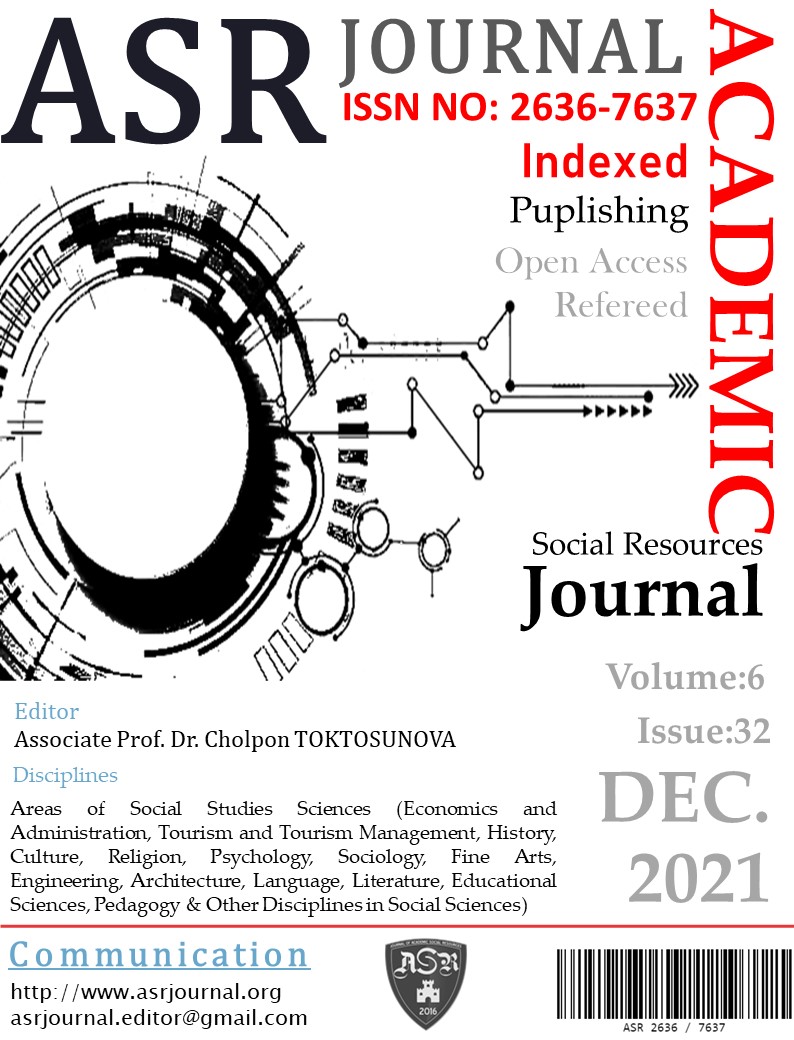KÜLTÜR VE SANAT İLİŞKİSİ BAĞLAMINDA İÇ ANADOLU BÖLGESİ KİLİMLERİNDE YER ALAN KURTAĞZI MOTİFİNİN DEĞERLENDİRİLMESİ
Author :
Abstract
Orta Asya’dan Anadolu’nun çeşitli bölgelerine göç eden ve burada yaşamlarını sürdüren Türk halkı, günlük hayatın içinde barınma, korunma, ev döşemesi vb. ihtiyaçlar için dokuma sanatını ustalıkla icra etmişlerdir. Türk kültürü içerisinde önemli bir yere sahip olan kilim dokumalar, kültürel birikim sonucunda ortaya çıkmış ve toplumsal hafıza görevini üstlenmiştir. Kilimleri bu denli değerli kılan aşk, ölüm, korku, nazar, umut ve kolektif düşünceleri yansıtan motiflerin bu dokumalarda kullanılmasıdır. Kendine has dilleri ve alt metinleri olan motifler, isim olarak yöreden yöreye farklılık gösterse de kullanım amacı hemen hemen aynı olmakla beraber soyut sanatın en yalın halidir. Anadolu’da farklı yörelerdeki kilimlerde yer alan motiflerden birisi de kurtağzı motifidir. Kurtağzı motifi “koruma” ve “korunma” ile ilişkilidir. Aynı zamanda kültürel anlatıları ve fonksiyonu olan bu motif, Anadolu’da ölümsüzlükle bağdaştırılan bazı geleneksel ritüellerin yorumlanmasıdır.Nitekim kurt, Türkler için oldukça önemli kabul edilen bir semboldür. Bu çalışmada İç Anadolu bölgesi kilimlerinde kullanılan kurtağzı motifinin kullanımı, çeşitleri ve özelliklerini tespit etmek amaçlanmaktadır. Çalışmada tarama modeli kullanılarak kurtağzı motifli kaynaklar incelenmiş ve 16 adet kilim çalışmanın örneklemini oluşturmuştur. Kilimlerde yer alan kurtağzı motifi renk, biçim ve form özellikleri bakımından incelenmiştir.
Keywords
Abstract
Turkish people who migrated to various regions of Anatolia and live here, are sheltered in daily life, protection, home furnishing, etc. They skillfully performed the art of weaving for needs. Rug weaving, which has an important place in the nomadic culture, emerged as a result of cultural cumulation and assumed the duty of social memory. What makes rugs so valuable is the use of motifs that reflect love, death, fear hope and collective thoughts in these weavings. Although motifs with their own unique languages and sub-texts differ from region to region as the name, the purpose of use is almost the same, but it is the simplest form of abstract art. One of the motifs in rugs in different regions in Anatolia is the wolf mouth motif. The wolf mouth motif is associated with "protection" and "protection". This motif, which also has cultural narratives and functions, is the interpretation of some traditional rituals associated with immortality in Anatolia. As a matter of fact, the wolf is a symbol that is considered very important for the Turksis people. In this study, it is aimed to determine the use, types and characteristics of the wolf mouth motif used in the rugs of the Central Anatolia region. In the study, wolf mouth motif sources were examined using the scanning model and 16 rugs constitute the sample of the study. The wolf mouth motif included in the rugs has been studied in terms of color, shape and form characteristics.
Keywords
- Abidin, A. F. (2018). “Tekstil Müzeleri ve Türkiye İçin Bir Tekstil Müzesi Örneği”, Yüksek Lisans Tezi,
- Abidin, A. F. (2018). “Tekstil Müzeleri ve Türkiye İçin Bir Tekstil Müzesi Örneği”, Yüksek Lisans Tezi, Akdeniz Üniversitesi Sosyal Bilimler Enstitüsü, Antalya.
- Aksel, M. (2011). Sanat ve Folklor (2. Basım), Kapı Yayınları, İstanbul.
- Arslan Kalay, H. ve Subaşı, E. (2016). “Eskişehir Arkeoloji Müzesi’nde Bulunan Afyon Yöresi Kilimlerinden Örnekler”, SDÜ ART-EGüzel Sanatlar Fakültesi Sanat Dergisi, 9 (17), 62-87.
- Bozkurt, S. (2020). “Geleneksel Türk Halı Sanatında Kullanılan Motiflerin Anlamları: Sındırgı-YağcıbedirHalıları Üzerine Göstergebilimsel Bir Analiz”, Gümüşhane Üniversitesi İletişim Fakültesi Elektronik Dergisi (e-gifder), 8 (1), 697-731.
- Çevik, N. (2005). “Kültürlerarası İlişki ve Etkileşim Kuramları Üzerine, Türk Arkeoloji ve Etnografya Dergisi”, 5, 111-122.
- Çoruhlu, Y. (2002). Türk Mitolojisinin Ana Hatları, Kabalcı Yayınevi, İstanbul.
- Duran, R. (2002). “Türk Süsleme Sanatlarındaki Motif ve Kompozisyonların Kültürel Kaynakları: Mitler ve Destanlar Üzerine”, Selçuk Üniversitesi Sosyal Bilimler Enstitüsü Dergisi, 8, 151-168.
- Erbek, M. (2002). Çatalhöyük'ten Bugüne Anadolu Motifleri, Dösim Yayınları, Ankara Karadeniz, C. (2018). “Müze Kültür Toplum”, İmge Kitabevi Yayınları, Ankara.
- Kayabaşı, N.; Bozkurt, H. ve Özkoca, B. (2016).“Çorum El Sanatlarında Kullanılan Motifler ve Anlamları”,Çorum El Sanatlarında Kullanılan Motifler ve Anlamları Hitit Üniversitesi Sosyal Bilimler Enstitüsü Dergisi, 1, 39-61.
- Koca,S. K. (2004).“Türk Kültüründe Ongunlar ve Semboller”, Yüksek Lisans Tezi, Sakarya Üniversitesi/Sosyal Bilimler Enstitüsü, Sakarya.
- Ögel, B. (1971). Türk Kültürünün Gelişme Çağları II, Milli Eğitim Basımevi, İstanbul.
- Ögel, B. (2010). Türk Mitolojisi I. Cilt (5.Baskı),Atatürk Kültür, Dil ve Tarih Yüksek Kurumu Türk Tarih Kurumu Yayınları, Ankara.
- Özpulat, F. ve Yurt, D. (2011). “Günümüz Baskı Desenli Kumaşlarında Desen Tarzları ve Teknikleri”, Akdeniz Sanat, 4 (7), 29-31.
- Read, H. (2018). Sanat ve Toplum, (Çev. Elif Kök), Hayalperest Yayınevi, İstanbul. Ünal, Ş. (1995). AnatolianKilims, Dösim Yayınları, Ankara.
- Yeşilbaş, E. (2011). “Diyarbakır Karacadağ Kilimlerinin Desen ve Motif Özellikleri”, Arış, 6, 112-117. İnternet Kaynakları
- https://hakkari.ktb.gov.tr/TR-159362/hakkari-kulturunde-kullanilan-motifler.html adresinden 30.10.2021 tarihinde alınmıştır.
- http://www.avsarelleri.com/?pnum=417&pt=6++KURTA%C4%9EZI%2C+KURT+%C4%B0Z%C4%B0% 2C+CANAVAR+AYA%C4%9EIadresinden 30.10.2021 tarihinde alınmıştır.





